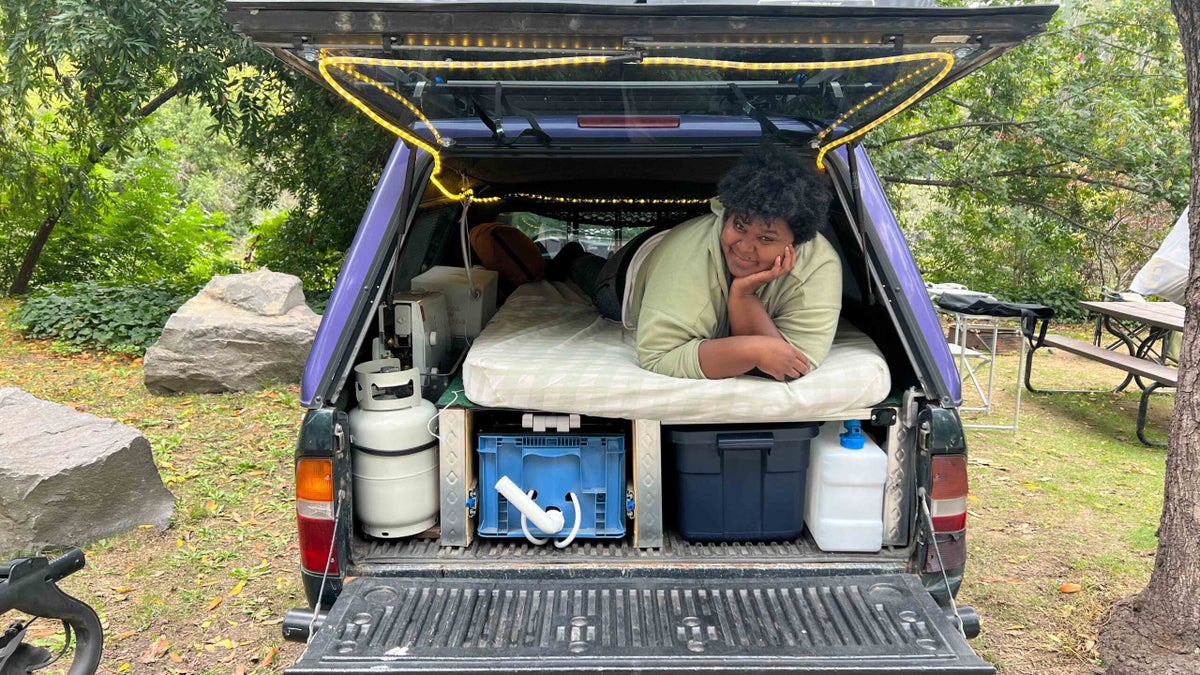No products in the cart.
Outdoor Adventure
How I Made the Perfect Tacoma Camper Truck
The decision to spend weeks on the road exploring the U.S. was not easy, but figuring out where to go was simple—I want to go everywhere! Once I was all in, I just needed a way to do it: a home and conveyance. A camper.
Last year, when I began considering my potential home on wheels, I knew I wasn’t going to be one of those people in a towering Sprinter with sleek blonde wood finishes and a hydraulic bed inside. For one thing, I can’t afford it, and for another, it is decidedly not my vibe. Don’t get me wrong, I like nice things, but I’m a wee bit of a dirtbag and extremely hard on my stuff. Function had to be the name of the game.
The truck I ended up buying and which my father and I turned into a tiny but well-appointed camper is basically me personified. A well-loved, slightly battered, but still-in-great-condition 1998 first-generation Toyota Tacoma. Shortly after acquiring the truck from my brother (who acquired her from a family friend who’d bought her new), I sourced a pearl purple high-top camper shell, and the vision was complete. Like some kind of utilitarian Mardi Gras float, Queenie was born.
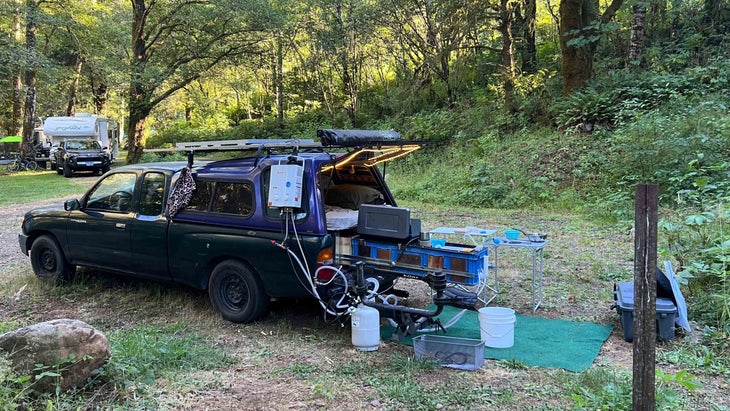
I already had the perfect destination for the maiden voyage of my new truck camper. Having grown up touring national parks with my family, I always wanted to go to Glacier National Park in Montana, but never had the chance. I plotted a route from my home base of Santa Rosa, California: north up the coast to a camping/glamping resort in Southern Oregon, a stop in the Willamette National Forest to check out the McKenzie River Trail, stops in Eugene and Portland to see friends, east through Washington to Spokane, through Northern Idaho, and then to the main event.
But first I had to finish building out my camper.
What I had thought would take a few months instead took about a year to complete. Between the schedules of the family and friends helping, global-supply chain issues, and a generally relaxed schedule, we finished just in time to get me on the road for this past summer.
In his youth, my father, Charles, embarked on a similar project of his own, building the majority of a camper shell for his truck, but he’d eventually stalled out. “I’ve been through beginning a project but not being able to see it through,” he said, “and I don’t want that for you.” His experience deepened his investment in my build, and I never could have done it without him and his motivation.
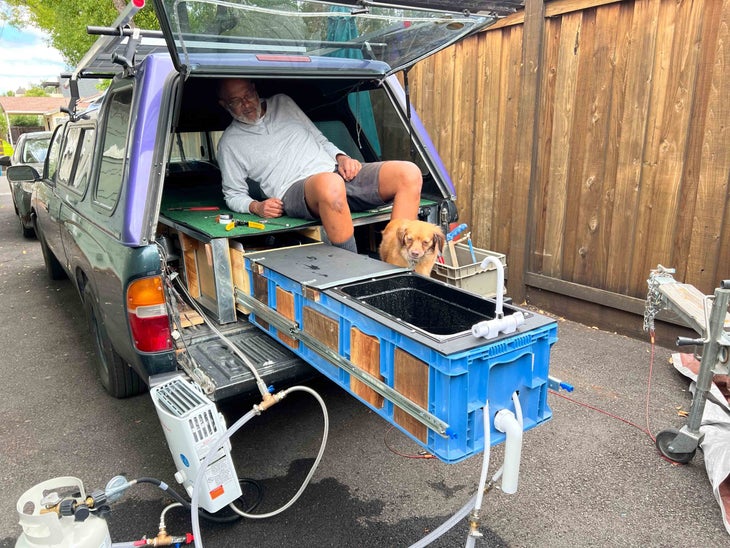
A year ago, when our mission began, I spent hours scouring Tacoma message boards and looking at other folks’ builds, finally zeroing in on a basic concept: a sleeping platform with a pull-out kitchen and storage hatches underneath. I knew I didn’t want to make the platform out of wood because of weight and durability, and after a brief dream of having a frame welded out of rectangular aluminum tubing that didn’t work out because of the welder’s busy schedule, my dad and I landed on steel framing.
When it came time to construct the pull-out kitchen, I knew I didn’t want to build a heavy box out of wood to house it. Instead I found an industrial plastic crate that fit the dimensions. Heavy-duty locking drawer slides rated for up to 600 pounds would allow the crate to slide in and out. I just had to figure out how to attach them to the ridged surface of the bin.
It was around this point that we started using the word “contraptioneer” a lot. The wooden blocks we glued and screwed to the bin so that we could install the drawer slides? That was an act of contraptioneering. It means it’s usually not pretty but it functions how you need it to and it solves a problem.
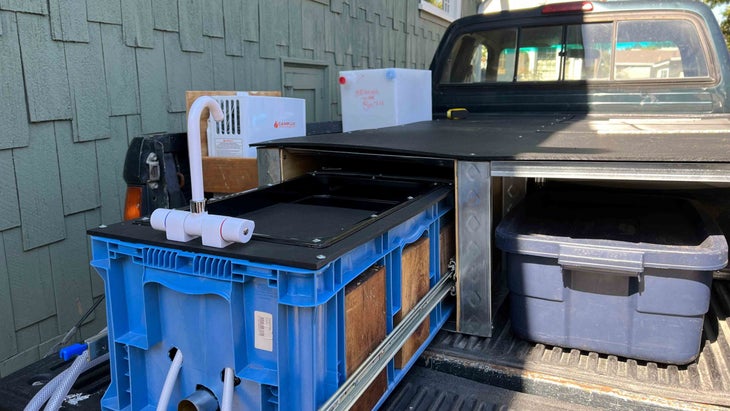
Having running water was a big dream of mine: If I was gonna make it on this journey, I needed a convenient, doable way to be able to shower and generally clean up. So I ordered a 10-gallon water tank, a collapsable marine faucet, and a Camplux on-demand water heater, and started researching what kind of tubing we needed to run hot water.
To this day I truly never get tired of turning that tap on to scrub out my cast-iron skillet after dinner and having hot water come out. I look at my camp neighbors boiling pots of water in order to get their dishes mostly clean, and I laugh, replete with superiority.
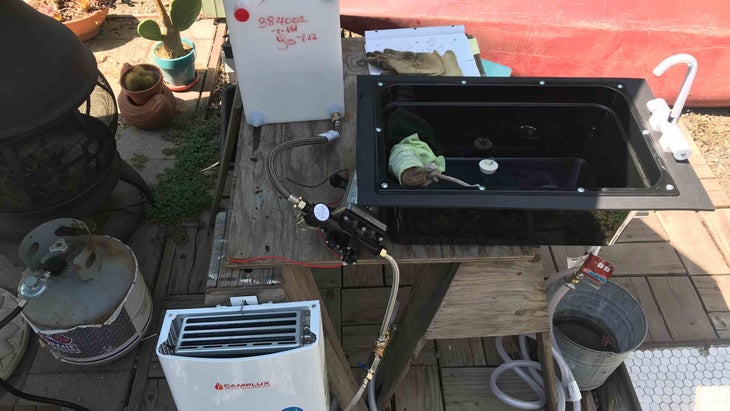
When it came to the electrical system, I knew what I wanted: a house battery that could be charged by solar or the alternator, an inverter for 120 power, and the ability to plug into shore power. Through reading countless accounts of van builds, I figured out the components I would need: two compact 100w solar panels, a 170AH lithium battery, a DC to DC charger with MPPT—all from Renogy—and an inverter and a battery charger from Samlex.
I’ll cut to the chase on this one. Putting the electrical system together was beyond either my or my father’s skills or patience, and North Bay Adventure Vans did a fantastic job installing it.
After the components were in place and wired together, my dad and I were able to use his rudimentary electrical knowledge to run power from the system to my SetPower 12V fridge cooler, some 12V LED lights, a 12V outlet, and the water pump for the sink/shower.
As I write now, on a cloudy day on the Oregon Coast, I’ve got plenty of power to do whatever I need, which will never stop being the absolute coolest thing to me.
Back to the build. Now that we had the nuts and bolts and guts in place, it was time to think about comfort and organization.
Two storage hatches on the right side of the platform are designated for my clothes. My kitchen supplies are stored in bins in the kitchen pull-out—dishes and utensils in one, tools and knives in the other, and my pots and pans are in a catch-all bin at the back of the slide. My food goes in an airtight tote so I don’t get rolled up on by critters in the night.
My mattress took some figuring. The first try was a hand-me-down memory foam, but I was too much person for that mattress. We needed air to appropriately support these curves. Over a couple of anxious days I went back and forth between REI & Sports Basement testing every mattress I could get my body on.
The size of my truck bed became the determining factor. Most of the mattresses I liked were too long, but Exped makes a short version of its Duo self-inflating foam + air mattress that fit into my space perfectly. The price tag was tough to swallow, but if there’s one piece of advice I’d give for living in your car, it’s to make sure your bed is truly comfortable. Not comfortable enough, but actually comfortable. You need a good night’s sleep to do anything and everything else on the road.
My mom made me a custom cover for my precious mattress along with some truly sweet seat covers that I think everyone should be a little more excited about, and every truck owner should be jealous of.
I also knew I needed some kind of awning for shade, and I went back and forth between the budget version and the one I really wanted. Eventually I decided to shell out for the good stuff and went with the Rhino Rack Dome 1300 Awning.
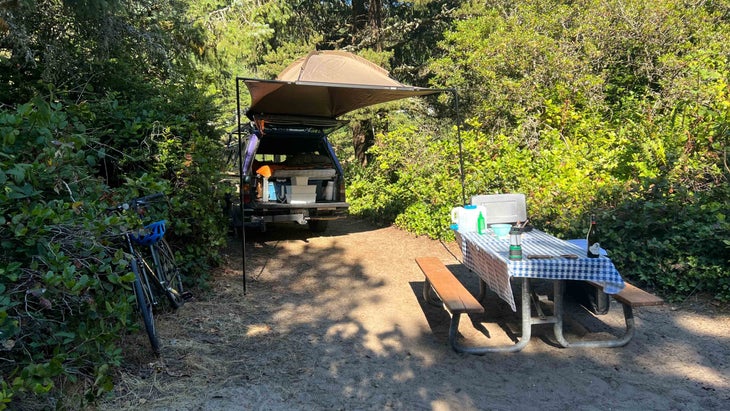
Later, my two nights at the Coldwater Cove campground in the Willamette National Forest were beautiful, but the days were rough with temperatures topping out around 104. I was beyond thankful to have my own shade.
As my preparations drew to a close, I debated taking my bike for a long time, until I saw the Kuat Pivot Rack. It lets me swing my bike out of the way rather than unload it to get into my truck bed without having to unload the bike. It also folds up to save space if I have unloaded my bike and locked it up at camp. Now I have the ability to go explore wherever I’m camped without getting back in the car after already driving here. Definitely bring your bike!
I love when I’m at a campsite, cooking dinner or washing dishes or just hanging out and seeing people’s eyes light up as they walk by my rig, with, “What is that??” writ large in their eyes. I always offer up a tour and take them through everything my small-yet-mighty vehicle can do.
The pride I have in knowing that I (mostly) didn’t pay someone to create my dream rig, but rather stumbled my way through it with my dear old dad grows every time someone says, “Nice set-up.”
I launched on my first trip in mid July and was on the road for four weeks. I am proud to report that everything on the truck functioned exactly as intended during this first trip, though that doesn’t mean everything went as planned. I ran into a major heatwave in the PNW with triple-digit temperatures at almost all of the stops I had planned on the way to Glacier.
Given that my truck doesn’t have AC, I made the tough call to change my plans and take a tour of the Oregon coast instead. Yes, I learned my lesson and will be getting my AC charged—horsepower be damned! While I was absolutely bummed to cancel Glacier, one of the best parts about truck camper travel is how easily plans can be changed. Something that can’t be said if you’re flying!
For the last couple years I’ve lived near the excellent Sonoma Coast State Park, which contains some of the most beautiful coastline California has to offer. You can imagine my surprise when I found Oregon’s coast to be possibly even more stunning than that of my Golden State. The change in plans gave me the relief I needed from the heat as I cruised down the coast with the windows down, enjoying the sea smells and salt air in my face.
This fall I plan to take Queenie south and into the Mojave Desert, through Arizona and New Mexico to the White Sands National Park, and maybe even down into Texas to finally check Big Bend National Park off the list.
During my time on the road I encountered tons of camping rigs, and the majority are fancier than mine. Built-out Sprinters, slick towable teardrops, slide-in truck-campers, and everything else under the sun. While my rig might not be the shiniest or newest, knowing that *I* made her makes me love Queenie more than any fresh-off-the-lot rig.
I asked my dad if completing the truck gave him a sense of redemption about his own camper. He said, “You can’t go back in time, but I’m proud of what we did.”
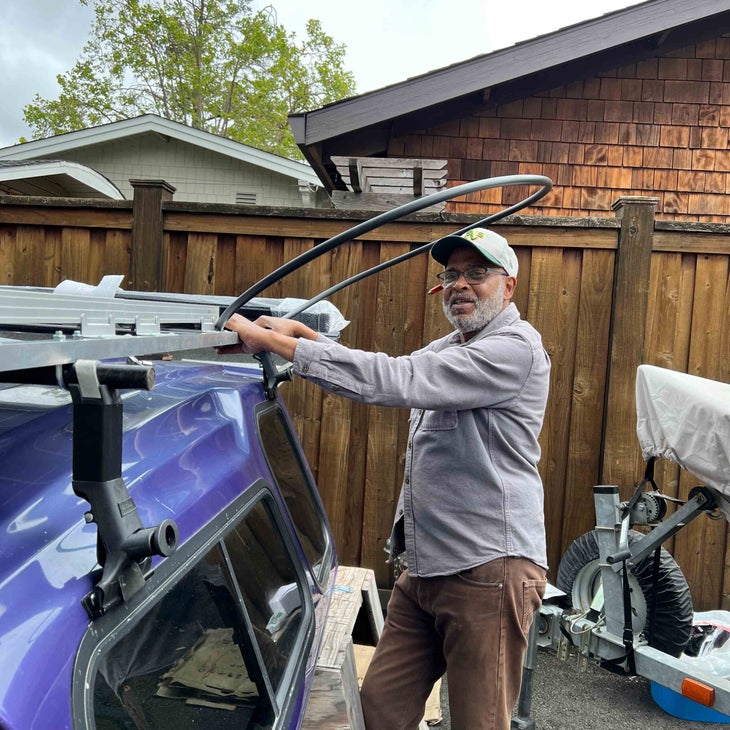
My camper truck is a constant source of inspiration for me, giving me confidence when I need it, and maybe even some to others. I like to think of my janky-yet-jaunty DIY rig as a potential catalyst for people to realize that their dreams—no matter how daunting—are closer than they imagine.
Queenie is not the 4×4, she’s not the V6—no, nothing fancy, but like me she works and shows no signs of slowing down. Sure, there have been times on unpaved roads when I wished I had a little more power to get where I was going, but we’re about 1,500 miles into our journey and haven’t gotten stuck yet.
Source link

